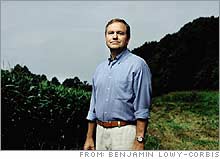|
Organic for everyone, the Wal-Mart way America's biggest company is also the world's biggest purchaser of organic cotton.
NEW YORK (Fortune) -- The $300-billion global cotton industry uses more pesticides and synthetic fertilizers than any other crop. Cotton Inc., the industry trade group, says that's nothing to worry about, but you don't have to be a scientist to know that applying tons and tons of pesticides to the soil - more than 50 million pounds in the United States alone - probably isn't a good thing. Just ask H. Lee Scott, the chief executive of Wal-Mart Stores (Charts), which in the last couple of years has become the world's biggest purchaser of organic cotton.
"Those toxins don't stop at the field, but can leach into the waterways, and may eventually find their way into animals, food and children," Scott said in a speech last year. You probably know by now that Wal-Mart has launched a sweeping drive to adopt business practices that are good for the environment. You may have heard that Wal-Mart has been selling organic cotton. This is the story behind the story - how and why the company got involved, and how it's changing an industry. The story begins, not with Scott, but with a woman named Coral Rose. A native of southern California, Rose buys organic food, wears organic clothes and uses all-natural cleaning products for her home. "I've lived an organic lifestyle for about 15 years," says Rose. Both her parents died of cancer; that'll get you thinking about chemicals in the air, water and food supply. Rose worked for the clothing chain Wet Seal before joining Sams Club, a division of Wal-Mart, as a ladies apparel buyer. In the spring of 2004 - before Wal-Mart launched its sustainability initiative - she placed an order for organic cotton yoga outfits for Sams Club. Although Sams Club is aimed at owners of small businesses, the stores stock a limited selection of women's clothes, as a "pick-me-up" for customers who are there to buy other stuff, Rose explains. The pastel-colored yoga tops sold for less than $10, the loose-fitting pants for less than $14. They were a big hit - about 190,000 units sold out in 10 weeks. That got Lee Scott's attention. "We gave our customers something they wanted, but something they might not have been able to afford at specialty stores," he said. It was an early sign that Wal-Mart's working-class and middle-income customers would be willing to buy "green" products, so long as they were affordable. Wal-Mart began working with a nonprofit trade group called the Organic Exchange, which has been promoting the use of organic cotton around the world since 2002. The company's buyers and suppliers toured organic cotton farms in Texas, California and Turkey, which is the world's biggest grower of organic cotton. One trip, to a farm near the town of Firebaugh, Ca., was especially memorable. They visited organic fields and then looked at a crop-dusting facility, to learn about chemicals and pesticides. "There were crop dusters in the air the whole day. It was pretty intense," said Rebecca Calahan Klein, the founder and director of the Organic Exchange. Today, Wal-Mart and Sams Club stock a range of organic cotton products - baby clothes under the Baby George brand, teenage fashion, and a line of bedsheets and towels. They've sold 5 million units of organic cotton ladies apparel in the last two years, insiders say. In none of this was Wal-Mart an innovator. Patagonia converted its entire sportswear line to organic 10 years ago. Nike (Charts) promoted organic cotton, as did others, like Eileen Fisher and Timberland (Charts). Retail sales of organic cotton have doubled, from $245 million in 2001 to $583 million in 2005. But the global supply was growing rapidly too, and some farmers who converted to organic methods, which can cost more, could not find buyers willing to pay a premium. They were forced to sell their crop into the conventional cotton market at lower prices. Wal-Mart's entry has changed the game. Five years ago, global production of organic cotton amounted to about 6,400 metric tons. In 2006, Wal-Mart and Sams Club will use about 6,800 metric tons. "They will be the largest buyer, by far," says Klein. Just as important, Wal-Mart has made a verbal five-year commitment to buy organic cotton, giving farmers the assurance they need to produce it. Beyond that, Wal-Mart will bring visibility to organic cotton. "Wal-Mart has the biggest megaphone of every company in the world," Klein says. "As they have more organic products on their shelves, it will affect what consumers expect to see." The Wal-Mart effect extends to the cotton-growing regions of Turkey. Kees Maris, a Dutchman who oversees a private organic cooperative of about 2,000 farmers called Mavideniz flew all the way to Wal-Mart's home office in Bentonville a couple of weeks ago to talk about organic cotton. While other companies are also driving demand for organics - his farmers grow figs and apricots along with cotton - Wal-Mart is one of the few to get directly involved with the farmers. "Their approach is very positive," he told me. To be sure, the organic cotton business remains small - less than 1 percent of the global cotton industry. Cotton Inc., by the way, argues that too much fuss is being made about pesticides and herbicides used by conventional methods. "Farmers who live and work on their land have every personal and economic incentive to use fewer chemicals in production, not more," the organization says. You can find their point of view here. The environmental case is put forth by the Organic Exchange and by an activist group called PANNA. Make up your own mind, but know that the next time you shop, you are doing more than buying a T-shirt or a dress. You're voting with your dollars for one way of doing business, or another. |
|

